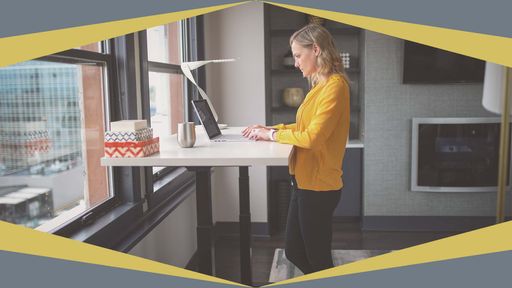How to Boost Your Physical and Mental Health While Working from Home

by Nathan Allen

Some 98 percent of remote workers say they would like to stay at least partially remote for the rest of their careers. Another 97 percent evangelize the virtual lifestyle and encourage others to work remotely. And 89 percent say they’re happy with their current amount of remote work or would like to increase the time spent working remotely.
You Know the Benefits
Though we sometimes get tired of those Zoom meetings (you know who still doesn’t know how to mute themselves), working from home offers a flexible schedule, which remote workers say is the biggest benefit of staying out of the traditional office. It allows workers to skip the commute. It’s good for the environment and has been dubbed “a huge opportunity for high-impact climate policy.” According to a survey of more than 1,000 remote workers published earlier this year, it can also boost mental health.
But Working from Home Can Have Downsides

Research also shows potential downfalls of the remote lifestyle. The same study that shows working away from the office can boost mental health also reveals 87 percent of remote workers have had “at least one negative impact on their life” from virtual work. Loneliness is the biggest culprit, especially for survey respondents under age 34. Working and living in the same space makes it harder to unplug and to exercise; working at home also means you’re always close to those snacks in the fridge and pantry. Another issue is that many parents now juggle a newly remote job and full-time daycare with children also staying at home.
Try These Tips for Creating a Healthier Work-from-Home Life
So, how can remote workers not only survive but also thrive in a virtual lifestyle? Here are some tips.
Create Connection to Avoid Loneliness

Let’s get the big one out of the way first. Studies show remote workers most often struggle with loneliness and missed social connections. Loneliness can lead to both mental and physical ailments. Most researchers define loneliness as being without a needed relationship or set of relationships, not just being physically alone (although that can also happen working remotely). As Gallup puts it, “Loneliness is emotional. Isolation is structural.” Meaning, loneliness is a response to lack of connection and can happen in or outside of the office. Isolation, on the other hand, is about lack of access—in other words, it’s a technical issue, not an emotional one. Of course remote workers can feel both lonely and isolated, but the studies identify loneliness most consistently as the more-significant problem.
So how do people working from home create the human connections they used to get at the office? We suggest two ways to go about this:
-
Maintain relationships with people at your company. For example, instead of walking with a coworker to a nearby coffee shop, invite them for a 15-minute virtual coffee chat. And do it frequently with different coworkers.
-
Build relationships with others in your local remote-work community. “Connecting with others in person who understand your work style can be an awesome support system as you acclimate to remote work,” is how this Buffer guide puts it. Try getting a pass to a local coworking space. You can also post up in local coffee shops and reach out to other laptop-toting workers looking for the nearest wall outlet. Many professional organizations are sponsoring meet-ups (online or in person) to help remote workers stay connected.
Make Sure You Take Time to Unplug
Buffer’s most recent State of Remote Work report shows nearly 20 percent of remote workers struggle with not being able to unplug. It makes sense. After all, the laptop, desktop, or cell phone is always there, not to mention those constant emails and notifications.
One way to combat this is to have a separate room for your office. Work stays in that room. When you leave, work stops. Simple. If an entire room isn’t available, at least make sure your workspace doesn’t blend with your space for downtime.
Either way, make sure to set expectations about your availability and keep blocks in your calendar. Talk to your employer about when you can have an hour or so “not available” block and then stick to it.
Move Your Body
When researchers in 2018 found that “sitting was the new smoking,” the media went crazy with that eyeball-grabbing headline. Still, research consistently confirms the “globesity” spreading across the world due to technology and jobs that require a lot of screen time.
The World Health Organization recommends the average adult get at least 150 minutes of moderate exercise or 75 minutes of vigorous exercise each week. Once again, setting boundaries and expectations are important, as the WHO also recommends getting those 150 minutes in blocks of at least 10 minutes at a time. The Mayo Clinic recommends not sitting for longer than 30 minutes at a time.
Sounds like a lot, but fear not. There are daily ways to keep moving in the modern work-at-home lifestyle.
- Create standing or active workstations
Studies show proven moderate health benefits compared to sitting. But a standing or treadmill desk is not always accessible—or productive—for all. And while standing or walking for portions of the workday is better than sitting, it’s not the same as getting moderate or vigorous exercise. So also consider these:
- Walk or stretch while on phone or conference calls
- Walk away from the computer every half-hour or hour. Set an alert.
- Block out time on your calendar (see above) especially for exercise. “Exercise” can mean a quick fast-walk, or a brief yoga or core routine.
If these can happen only two or three times a week, that’s still good. It’s also important that, whatever you do, it’s something that you enjoy.
Consume Your Carbs Wisely

When you’re working at home, the kitchen is close. Very close. You can be tempted to eat too much or too often, or just the wrong things. What you eat impacts productivity and mood. When fueling for work productivity and a healthy lifestyle, consider these two rules: Carbs can squash productivity, and low glucose means diminished brain function.
To be clear, taking carbs totally out of a diet does not lead to increased productivity. But the timing of consuming carbs—and the quantity—can. Generally, saving the complex carbs for later in the day is best. Simple sugars found in fruits and vegetables can provide the blood sugar needed for optimum brain function without the crash you can experience after eating a big bowl of mashed potatoes. “The brain is dependent on sugar as its main fuel,” Harvard Medical School professor Vera Novak said in a study linking glucose levels to brain function.
As with most things in life, moderation is important. Consuming multiple small, nutritionally balanced meals or snacks, rather than the traditional “three squares” can lead to optimum performance.
One More Tip: Consider Learning a Simple Meditation Practice
Meditation isn’t just for the sage on a mountaintop or Zen master at a monastery. It can also be a daily ritual for the modern remote worker. Sure, the practice of meditation began thousands of years ago as a way to awaken and create deep understanding to alleviate suffering. But more recent science has shown how the practice of following the breath also can help reduce stress and anxiety as well as manage high blood pressure, chronic pain, and depression.
While sitting meditation might be the most commonly thought-about form of meditation, there are also more active forms: yoga, Tai Chi, and walking meditation. Try out some sitting guided meditation to start. You can find guided meditations on YouTube or on meditation and sleep apps like Calm or Headspace. Practicing for just 10 or so minutes a day for a few days or weeks can reduce anxiety and boost concentration.
There you have it. Using these tips as a base, experiment with your own routine and schedule to find out what works best for you to live the best life possible as a virtual worker.









